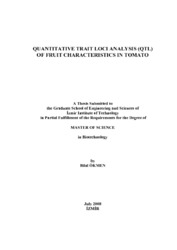Please use this identifier to cite or link to this item:
https://hdl.handle.net/11147/3322Full metadata record
| DC Field | Value | Language |
|---|---|---|
| dc.contributor.advisor | Doğanlar, Sami | en |
| dc.contributor.author | Ökmen, Bilal | - |
| dc.date.accessioned | 2014-07-22T13:51:20Z | - |
| dc.date.available | 2014-07-22T13:51:20Z | - |
| dc.date.issued | 2008 | en |
| dc.identifier.uri | http://hdl.handle.net/11147/3322 | - |
| dc.description | Thesis(Master)--Izmir Institute of Technology, Biotechnology, Izmir, 2008 | en |
| dc.description | Includes bibliographical references (leaves: 75-79) | en |
| dc.description | Text in English; Abstract: Turkish and English | en |
| dc.description | xi, 93 leaves | en |
| dc.description.abstract | Tomato has a crucial part in the human diet. Therefore, many plant breeders have tried to improve horticulturally important traits such as yield, fruit size, shape and color. With increased attention on human health, plant breeders also consider the improvement of health-related traits of fruits and vegetables such as antioxidant characters. However, because most plant traits are controlled by more than one gene, improvement of crops that possess the desired traits is very difficult.Development of molecular marker techniques makes these processes feasible for plant breeders. In this study both health-related and horticulturally important traits were characterized for identificaton of their locations in the tomato genome using 152 Lycopersicon hirsutum BC2F2 mapping individuals. For this aim, all plants were phenotypically and genotypically characterized. It was expected that some alleles from the wild species L.hirsutum had the capacity for improvement of both antioxidant and agronomically important traits of elite lines.A total of 75 QTLs were identified for all traits. Of the 75 QTLs, 28 were identified for five antioxidant traits including total water soluble antioxidant capacity, vitamin C, phenolic, flavonoids and lycopene content and 47 QTLs were identified for 8 agronomic traits including external and internal fruit color, fruit weight, firmness, fruit shape, stem scar size, locule number and wall thickness. Seventeen of these QTLs were also identified by previous studies. Markers linked with these QTLs can be used in Marker Assisted Selection (MAS) for improvement of elite tomato lines. | en |
| dc.language.iso | en | en_US |
| dc.publisher | Izmir Institute of Technology | en |
| dc.rights | info:eu-repo/semantics/openAccess | en_US |
| dc.subject.lcc | SB349. O417 2008 | en |
| dc.subject.lcsh | Tomatoes--Genetics | en |
| dc.subject.lcsh | Antioxidants | en |
| dc.title | Quatitative trait loci analysis(QTL) of fruit characteristics in tomato | en_US |
| dc.type | Master Thesis | en_US |
| dc.institutionauthor | Ökmen, Bilal | - |
| dc.department | Thesis (Master)--İzmir Institute of Technology, Bioengineering | en_US |
| dc.relation.publicationcategory | Tez | en_US |
| item.grantfulltext | open | - |
| item.openairetype | Master Thesis | - |
| item.fulltext | With Fulltext | - |
| item.cerifentitytype | Publications | - |
| item.openairecristype | http://purl.org/coar/resource_type/c_18cf | - |
| item.languageiso639-1 | en | - |
| crisitem.author.dept | 03.01. Department of Bioengineering | - |
| Appears in Collections: | Master Degree / Yüksek Lisans Tezleri | |
Files in This Item:
| File | Description | Size | Format | |
|---|---|---|---|---|
| T000683.pdf | MasterThesis | 2.85 MB | Adobe PDF |  View/Open |
CORE Recommender
Page view(s)
128
checked on Apr 29, 2024
Download(s)
38
checked on Apr 29, 2024
Google ScholarTM
Check
Items in GCRIS Repository are protected by copyright, with all rights reserved, unless otherwise indicated.